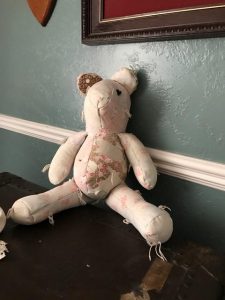
Collecting: What Records Do You Need?
Provenance (from the French provenir, to “come from) is the chronology of the origin, background or transmission of an object, such as art or artifacts. It can also refer to the history of the ownership of an item. Provenance is vitally important in the world of art and archaeology. And it can be important in the teddy bear world as well especially for serious owners with extensive collections or who are actively accumulating more teddies.
It would be great if teddies could talk and tell us all about their heritage, but unfortunately they can’t. So they leave clues for us to help us discover where they’ve been and what they’ve seen.
Manufacturers, as with ownership, are also part of a teddy bear’s provenance. Manufacturers often put identifying marks, buttons, tags, or stitching on the bears to show who made them. Some manufacturers such as Steiff and Dean’s Rag Book were very diligent about labeling, while others such as Ideal were not very good at that at all. However, many of the tags or labels used to identify the manufacturer disappear over time, often leaving us guessing as to who his maker is. And with fakes on the market, it is important to verify as best as possible the bear’s true origin.
Regarding the age of a teddy bear, it’s important to know the primary years the manufacturer was in business, whether they suffered a lull during the war years in order to make war materials, and whether they were at some time bought by another company and when. Or even, sadly enough, whether they’ve gone completely out of business, and when.
And all this information contributes to another aspect of owning teddy bears – rarity. How many were made and how many are still alive? Rarity adds value, not only in the eyes of the collector but also in the price asked and paid. And if the bear was made as part of a bear club’s offering or as a collector’s item this in itself makes him kind of rare since these types of bears are usually produced in limited numbers.
Prior owners are part of a teddy’s heritage. If you buy your teddy bear at a garage sale or thrift store, more than likely this information will be missing, as will all type of records for the bear. But if you buy him at an antique store, or through a private sale, or especially through an auction, he should come with at least some papers.
Also helpful are prior bills of sale showing how much the prior owners paid for their bear. It helps establish paternity and value.
The overall condition of the bear should be noted, as well as any repairs. Older bears will show natural wear and tear whereas newer ones should be in better shape. Repairs that are well-done won’t detract from the value of the bear whereas clumsy repairs might. Clothes can also help with dating the teddy if they are originals that came with the bear when he was originally purchased.
And just as these are the types of records you would want for your teddy, be sure to continue the record keeping on your teddies. For who knows, someday they may pass on to a new owner who would also like to know their history. And if the bear doesn’t come with any documentation, start a record when you buy him so you can at least make him feel welcome and glad to be adopted.

Hi, I’m Colonel Teddy, the official mascot of Casa de Bear. I get my name from President Theodore (Teddy) Roosevelt, who started the teddy bear craze here in the U.S. I’m proud to have been named for such a famous person.
I’ve been around for a while, but can’t tell you my story because I don’t have vocal cords to talk or hands to write. Suffice it to say I wound up sad and lonely on a boutique shelf in a thrift store in Sacramento, California, where I was adopted by my current “mama.” I’m in pretty good shape except I seem to have lost my glasses somewhere in all my adventures.
My mama loves me and takes good care of me, and I have quite a few brothers and sisters to keep me company. I even survived a cross country move to Texas. What else could a teddy wish for?
It would be nice if my mama knew about my rich heritage, but sadly she doesn’t because I didn’t come with any papers. Please keep records for your teddies so their human families know their stories.
Thank you for dropping by,
Col. Teddy
